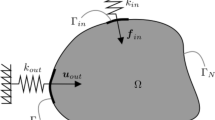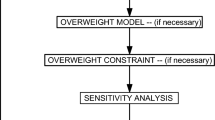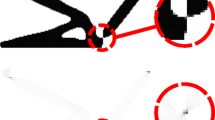Abstract
This paper presents a unique solution to the problem of planar compliant mechanism design by means of geometric morphing technology and isogeometric analysis (IGA). A new transformable triangular mesh (TTM) component is developed based on geometric morphing technology, which can generate the required topology with different feature sets from a surface that has zero boundary component (interior hole) under the control of Laplace energy and mesh operations. Such flexible TTM component is helpful in overcoming the initial dependency of conventional topology optimization methods in which the layout of parameterized components often affects final optimized results. As the high-order continuity between the grids of IGA can improve calculation accuracy and numerical stability, IGA is combined with the presented TTM algorithm to establish a two-layer computational model so as to identify the optimal compliant mechanism topology within a given design domain and given displacements of input and output ports. In the upper layer of the model, the compliant limbs are characterized explicitly by triangular grids. By moving, splitting, and refining these triangular grids, the generated shape will then be projected onto the lower layer which is discretized using NURBS elements so as to calculate structural sensitivity for driving new iteration. To demonstrate the benefits provided by such method for compliant mechanism design, several numerical studies are tested, in which the geometry freely evolves along the optimization procedure, resulting in more efficient non-trivial topologies with desired kinematic behavior.



















Similar content being viewed by others
References
Alexa M, Cohen-Or D, Levin D (2000) As-rigid-as-possible shape interpolation. //Proceedings of the 27th annual conference on Computer graphics and interactive techniques. ACM Press/Addison-Wesley Publishing Co.: 157-164
Allaire G, Jouve F, Toader AM (2004) Structural optimization using sensitivity analysis and a level-set method. J Comput Phys 194(1):363–393
Ananthasuresh GK, Kota S, Gianchandani Y (1994) A methodical approach to the design of compliant micromechanisms. Solid-State Sensor and Actuator Workshop:189–192
Areias P, Reinoso J, Camanho PP, César de Sá J, Rabczuk T (2018) Effective 2D and 3D crack propagation with local mesh refinement and the screened Poisson equation. Eng Fract Mech 189:339–360
Bendsøe MP (1989) Optimal shape design as a material distribution problem. Structural Optimization 1(4):193–202
Bendsøe MP, Sigmund O (2013) Topology optimization: theory, methods, and applications. Springer Science & Business Media
Campagna S, Kobbelt L, Seidel HP (1998) Directed edges—a scalable representation for triangle meshes. J Graph Tools 3(4):1–11
Cao L, Dolovich AT, Chen A, Zhang W (2018) Topology optimization of efficient and strong hybrid compliant mechanisms using a mixed mesh of beams and flexure hinges with strength control. Mech Mach Theory 121:213–227
Chen W, Zhang X, Li H, Wei J, Fatikow S (2017) Nonlinear analysis and optimal design of a novel piezoelectric-driven compliant microgripper. Mech Machine Theor 118:32–52
Chen Q, Zhang X, Zhu B (2018) A 213-line topology optimization code for geometrically nonlinear structures. Struct Multidiscip Optim 59(1)
da Silva GA, Beck AT, Sigmund O (2019) Topology optimization of compliant mechanisms with stress constraints and manufacturing error robustness. Comput Methods Appl Mech Eng 354:397–421
Dearden J, Grames C, Orr J, Jensen BD, Magleby SP, Howell LL (2017) Cylindrical cross-axis flexural pivots. Precis Eng 51:604–613
Dorn W, Gomory R, Greenberg H (1964) Automatic design of optimal structures. Journal de mecanique 3:25–52
Emmendoerfer Hélio (2018) Silva, Emílio Carlos Nelli, Fancello E A. Stress-constrained level set topology optimization for design-dependent pressure load problems. Computer Methods in Applied Mechanics & Engineering
Gandhi I, Zhou H (2018) Synthesizing constant torque compliant mechanisms using precompressed beams. J Mech Des:141(1)
Guo X, Zhang W, Zhong W (2014) Doing topology optimization explicitly and geometrically—a new moving morphable components based framework. J Appl Mech 81(8):081009
Guo X, Zhang W, Zhang J, Yuan J (2016) Explicit structural topology optimization based on moving morphable components (MMC) with curved skeletons. Comput Methods Appl Mech Eng 310:711–748
Hongzhe Z, Shusheng B, Bo P (2015) Dynamic analysis and experiment of a novel ultra-precision compliant linear-motion mechanism. Precis Eng 42:352–359
Hopkins JB, Panas RM (2013) Design of flexure-based precision transmission mechanisms using screw theory. Precis Eng 37(2):299–307
Howell LL (2001) Compliant mechanisms, John Wiley&Sons
Hughes TJR, Cottrell JA, Bazilevs Y (2005) Isogeometric analysis: CAD, finite elements, NURBS, exact geometry and mesh refinement. Comput Methods Appl Mech Eng 194(39-41):4135–4195
Jin M, Zhang X, Yang Z, Zhu B (2018) Jacobian-based topology optimization method using an improved stiffness evaluation. J Mech Des 140(1):011402. https://doi.org/10.1115/1.4038332
Kovacs D, Bisceglio J, Zorin D (2015) Dyadic T-mesh subdivision. ACM Transactions on Graphics (TOG) 34(4):143
Krishnan G, Kim C, Kota S (2011) An intrinsic geometric framework for the building block synthesis of single point compliant mechanisms. J Mech Robot 3(1)
Li L, Zhu X (2019) Design of compliant revolute joints based on mechanism stiffness matrix through topology optimization using a parameterization level set method. Struct Multidiscip Optim 60(4):1475–1489
Li B, Tang W, Ding S, Hong J (2020) A generative design method for structural topology optimization via transformable triangular mesh (TTM) algorithm. Struct Multidiscip Optim 62:1159–1183
Nguyen VP, Anitescu C, Bordas SPA, Rabczuk T (2015a) Isogeometric analysis: an overview and computer implementation aspects. Math Comput Simul 117:89–116
Nguyen VP, Anitescu C, Bordas SPA, Rabczuk T (2015b) Isogeometric analysis: an overview and computer implementation aspects. Math Comput Simul 117:89–116
Nishiwaki S, Frecker MI, Min S, Kikuchi N (1998) Topology optimization of compliant mechanisms using the homogenization method. Int J Numer Methods Eng 42(3):535–559
Norato J, Haber R, Tortorelli D, Bendsøe MP (2004) A geometry projection method for shape optimization. Int J Numer Methods Eng 60(14):2289–2312
Oswald P, Schröder P (2003) Composite primal/dual 3-subdivision schemes. Computer Aided Geometric Design 20(3):135–164
Pedersen CBW, Buhl T, Sigmund O (2001) Topology synthesis of large-displacement compliant mechanisms. International Journal for Numerical Methods in Engineering. https://doi.org/10.1002/nme.148
Puri S, Prasad SK (2015) A parallel algorithm for clipping polygons with improved bounds and a distributed overlay processing system using mpi //2015 15th IEEE/ACM International Symposium on Cluster, Cloud and Grid Computing. IEEE:576–585
Reddy A R (2008) Feature-based image metamorphosis. National Conference on Advanced trends in Information Technology", S.J.B.I.T. March 26, 2008, Bangalore
Rossignac J (1999) Edgebreaker: Connectivity compression for triangle meshes. IEEE Trans Vis Comput Graph 5(1):47–61
Sanò P, Verotti M, Bosetti P, Belfiore NP (2018) Kinematic synthesis of a D-drive MEMS device with rigid-body replacement method. J Mech Des 140(7):075001
Sederberg T W, Greenwood E (1992) A physically based approach to 2–D shape blending//Proceedings of the 19th annual conference on Computer graphics and interactive techniques: 25-34
Sederberg TW, Gao P, Wang G, Mu H (1993a) 2-D shape blending: an intrinsic solution to the vertex path problem// Conference on Computer Graphics & Interactive Techniques. ACM
Sederberg TW, Gao P, Wang G, Mu H (1993b) 2-D shape blending: an intrinsic solution to the vertex path problem//Proceedings of the 20th annual conference on Computer graphics and interactive techniques: 15-18
Sigmund O (1997) On the design of compliant mechanisms using topology optimization*. Mech Struct Mach 25(4):493–524
Sigmund O, Maute K (2013) Topology optimization approaches. Struct Multidiscip Optim 48(6):1031–1055
Sorkine O, Alexa M (2007) As-rigid-as-possible surface modeling// Proceedings of the Fifth Eurographics Symposium on Geometry Processing. Barcelona, Spain, July 4-6
Stanford B, Beran P (2011) Conceptual design of compliant mechanisms for flapping wings with topology optimization. AIAA J 49(4):855–867
Wang R, Zhu B, Zhang X, Zhang X, Chen Q (2018) Topology optimization of compliant mechanisms using moving morphable components with flexure hinge characteristic//2018 International Conference on Manipulation, Automation and Robotics at Small Scales (MARSS). IEEE:1–6. https://doi.org/10.1109/MARSS.2018.8481175.
Wang R, Zhang X, Zhu B (2019) Imposing minimum length scale in moving morphable component (MMC)-based topology optimization using an effective connection status (ECS) control method. Comput Methods Appl Mech Eng 351:667–693
Xia Q, Shi T (2015) Constraints of distance from boundary to skeleton: for the control of length scale in level set based structural topology optimization. Comput Methods Appl Mech Eng 295:525–542
Xie X, Wang S, Xu M, Wang Y (2018) A new isogeometric topology optimization using moving morphable components based on R-functions and collocation schemes. Comput Methods Appl Mech Eng 339:61–90
Yulin M, Xiaoming W (2004) A level set method for structural topology optimization and its applications. Adv Eng Softw 35(7):415–441
Zhang X, Xu Q (2019) Design and analysis of a 2-DOF compliant gripper with constant-force flexure mechanism. Journal of Micro-Bio Robotics
Zhang X, Zhu B (2018) Topology optimization of compliant mechanisms. Springer, Singapore
Zhang W, Yuan J, Zhang J, Guo Xl (2016a) A new topology optimization approach based on moving morphable components (MMC) and the ersatz material model. Struct Multidiscip Optim 53(6):1243–1260
Zhang W, Li D, Zhang J, Guo X (2016b) Minimum length scale control in structural topology optimization based on the moving morphable components (MMC) approach. Comput Methods Appl Mech Eng 311:327–355
Zhang W, Liu Y, Du Z, Zhu Y, Guo X (2018) A moving morphable component based topology optimization approach for rib-stiffened structures considering buckling constraints. J Mech Des 140(11):111404
Zheng S, Tang W, Li B (2020) A new topology optimization framework for stiffness design of beam structures based on the transformable triangular mesh algorithm. Thin-Walled Struct 154:106831
Zhu B, Chen Q, Jin M, Zhang X (2018) Design of fully decoupled compliant mechanisms with multiple degrees of freedom using topology optimization. Mech Mach Theory 126:413–428
Funding
The work reported in this paper is supported by the National Natural Science Foundation of China [51822507] and [U1913213].
Author information
Authors and Affiliations
Corresponding author
Ethics declarations
Conflict of interest
The authors declare that they have no conflict of interest.
Replication of results
The results presented in the paper can be reproduced. We do not want to public the codes. But readers can contact us to get the codes by E-mail: baotong.me@xjtu.edu.cn, zhiz2005@163.com
Additional information
Responsible Editor: Shikui Chen
Publisher's note
Springer Nature remains neutral with regard to jurisdictional claims in published maps and institutional affiliations.
Appendix
Appendix
For the ith interior non-control vertex, its Laplacian energy can be expressed:
In order to minimize energy function Ei, we only need to minimize the non-constant terms with Ri in Ei. Thus, the minimization of the Eq. (33) can be written as:
Furthermore, we introduce the covariance matrix:
where Di is a diagonal matrix that contains the weights wij. Pi is a 2 × N(j) matrix containing eij’s as its columns, and it is similar for Pi′. When RiSi is symmetric positive semi-definite, the rotation matrix Ri that maximizes Tr (RiSi) can be obtained. Ri can be derived from the singular value decomposition (SVD) of \( {\boldsymbol{S}}_i={\boldsymbol{U}}_i{\Sigma}_i{\boldsymbol{V}}_i^{\mathrm{T}} \):
up to changing the sign of the column of Ui that corresponds to the smallest singular value ensuring det (Ri) > 0.
Rights and permissions
About this article
Cite this article
Ding, S., Li, B., Chen, G. et al. Isogeometric topology optimization of compliant mechanisms using transformable triangular mesh (TTM) algorithm. Struct Multidisc Optim 64, 2553–2576 (2021). https://doi.org/10.1007/s00158-021-03008-9
Received:
Revised:
Accepted:
Published:
Issue Date:
DOI: https://doi.org/10.1007/s00158-021-03008-9




